13 Absolute Best Types Of Wood To Use For Smoking And Grilling
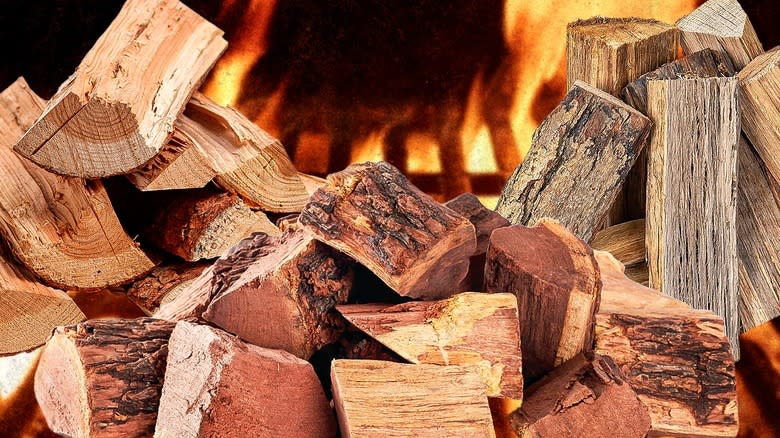
We've been around the barbecue block, sampling smoked meats and cheeses, drooling over cedar plank salmon, diving into juicy hickory ribs, and enjoying applewood bacon fried over an open fire. But since smoking is an art — and one we can always improve upon to enhance our grilling experience — Tasting Table reached out to pitmaster Will Hair of the SmokeMasters Championship BBQ Team, and Cary Kelly, butcher and meat-based recipe blogger, to determine the absolute best types of wood to use for smoking and grilling.
The best type of wood depends on the smoker or grill you're using and how often you plan on using it, as well as the food you'll be cooking. Both the equipment and food determine which wood you select, in addition to how much you use. With choices that include water smokers, stick burners, pellet grills, and charcoal grills, Hair advises newer cooks try a kettle grill or bullet smoker. For the more experienced smoker or serious pitmaster, Hair recommends water or pellet smokers.
Wood is best sourced locally, where it's readily available. Southerners may easily find woods like pecan and peach, while New England residents have easier access to woods like oak and maple. But more importantly, Hair emphasized taking time to learn about fire management in order to control the heat, regardless of the type or size of wood you use. And be sure to avoid using softwoods for cooking; they contain too much sap, which can create a fast, pungent burn.
Read more: Your Guide To The Different Cuts Of Steak
Oak
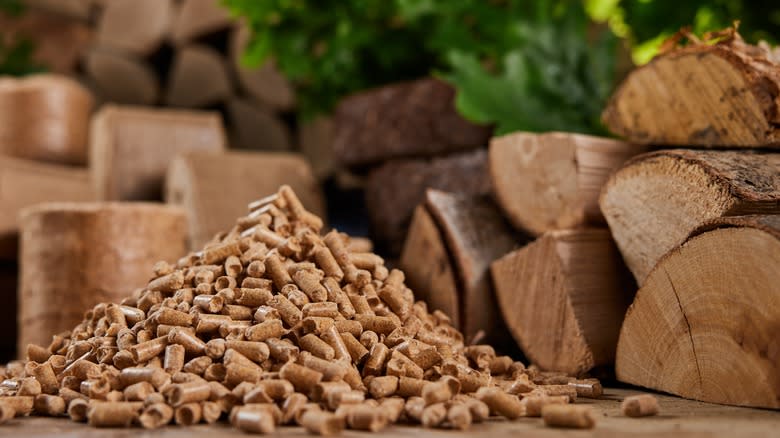
A go-to for champion pitmasters and popular barbecue joints, oak wood is a prime choice for smoking and grilling thanks to its dense structure, slow burn, and harmonious nature of partnering with red meat, pork, and fish.
"Oak and hickory are literally number one and two on the list of best woods to smoke with, interchangeable depending on where you are in the country," Will Hair told us. Lending an earthy, woodsy complement to foods, oak is known to burn hot and clean. But though it's mostly used for slow burning, there's no need to limit yourself since the size of the wood also contributes to how you control your cook.
Burn time is an important factor — grilling needs a wood that burns hot and fast to achieve maximum potential from the wood, while smoking requires wood to last a long time so you don't need to keep adding wood to your smoker. But you don't have to rely on the type of wood alone; consider the size of the wood pieces to help control the heat.
"I can use a hickory or an oak log on a slow burning fire for an extended length smoke, or I can use a hickory or oak wood chip on a hot fire and still manage to gain the advantage of the flavors without changing the type of wood I'm using, only the size," said Hair.
Hickory
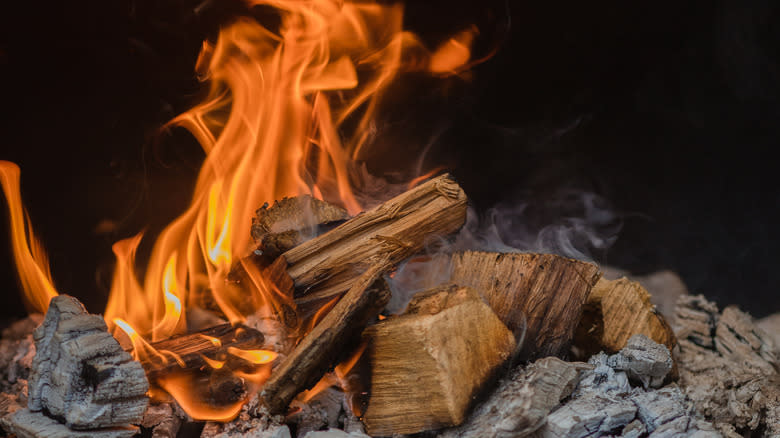
As one of the most popular choices and an easily accessible pick, hickory wood features a profile similar to oak, and pairs well with pork and beef. Hickory also works well for smoking cheeses. It has a deep intensity to it that can overpower more delicate foods or become too strong during longer cook times. With the right balance of smoke, the taste of hickory is reminiscent of molasses — a little sweet, rich, and somewhat nutty. It's the perfect complement to spicy or sweet barbecued rubs or sauces.
As leader of the SmokeMasters BBQ Championship Team in the Whole Hog, Pulled Pork, and Ribs competitions, Will Hair always uses a slow-burning charcoal for his typical pork butt cook. He told Tasting Table he uses Royal Oak Charcoal's lump charcoal, which is a blend of oak and hickory wood, but he also adds a mix of hickory and applewood at the start of cook time to boost the flavor profile of the pork.
"In Memphis, it's slow smoked hickory BBQ. We add in the fruit woods, in this case apple, but peach and cherry work as well, to keep the meat from getting too bitter after a long exposure to a hardwood like hickory," Hair said.
Apple
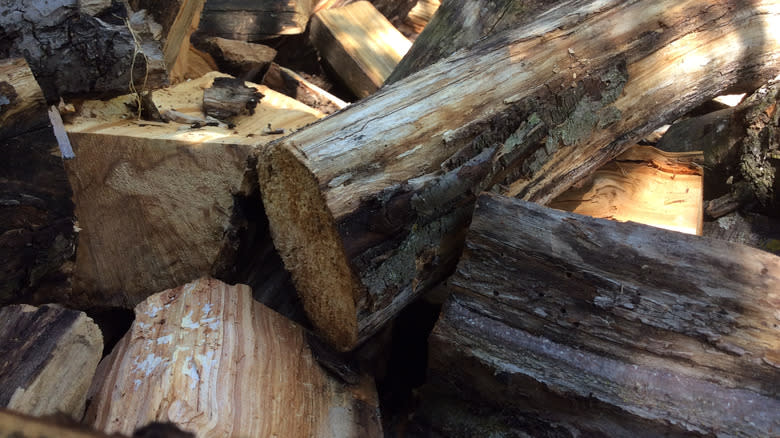
Applewood is milder and sweeter than many other cooking woods, and it highlights lighter-tasting meats such as pork and poultry. Though it may be preferred for white meat, applewood can also go well with beef.
"Apple smoked burgers were amazing," Cary Kelly told Tasting Table. Kelly — who follows a meat-based way of eating, and maintains an active social media presence portraying his nearly carnivorous lifestyle — likes applewood, but finds its price prohibitive. "Apple does seem to have a sweeter flavor to it, but costs more."
Though a little pricier than some other popular and well-loved woods for smoking and grilling, applewood is frequently used in competition barbecue, professional kitchens, and backyard smokers. Fruit woods are often combined with other woods to reach full potential. Combining hickory and cherry with applewood helped the SmokeMasters team, led by Will Hair, win the top spot for the Memphis Barbecue Network's Whole Hog competition in 2018 and 2019.
Bourbon Barrel
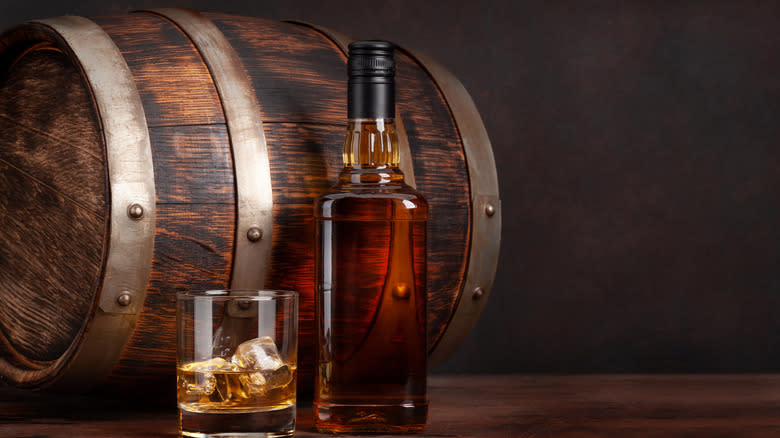
Bourbon barrel wood is sourced from newly emptied whiskey barrels made from white oak. And since oak is a go-to for pitmasters and barbecue aficionados, bourbon barrel adds yet another layer of flavor to flame-cooked meats.
Will Hair told Tasting Table that whiskey-saturated oak is currently his favorite cooking wood after receiving some of it from the Jack Daniel's distillery in Lynchburg, Tennessee. "It created one of the best briskets I think I've ever made," he exclaimed. Sounds good to us.
The barrel wood absorbs the complexities and properties of the liquor, which then transfers to the food you smoke the barrel wood with. Bourbon features a range of tastes, depending on the process and particular ingredients used. From a grainy bite to toasted nuttiness to sweet notes of caramel to the light spice of cinnamon, bourbon barrel wood elicits deep, rich, sultry notes that complement hearty cuts of meat, such as beef or lamb.
Smoking with bourbon barrel wood changes the color of your food, too, adding to the overall appeal of the end result. Cary Kelly told Tasting Table that he loves to get bourbon barrel wood to achieve "a really deep mahogany" color on his meat, giving him in an eye-catching creation.
Sugar Maple

Typically referred to as maple wood and perhaps most connected with maple-smoked bacon, maple is more commonly regarded as "sugar maple" in smoking circles, according to Will Hair. Often seen in the northern U.S., where the maple tree grows prolifically, sugar maple is a popular pick among barbecue enthusiasts because it's a strong, solid wood that features a long-burning profile that works well when combined with other woods.
Sugar maple wood delivers a mild, sweet smokiness to veggies, and is a great choice for smoking poultry and fish since its light sweetness doesn't overpower the food, and the wood burns for a lengthy amount of time.
"The tight grain and rock-hard texture give maple the ability to burn for extended lengths and impart a fantastic, sweet flavor as it smokes. Its one and only drawback in the BBQ venue is that maple tends to burn long, but not as hot as a hickory or an oak. This enables it to impart flavor without really adding the heat that other woods contribute so well," Hair added.
Mesquite
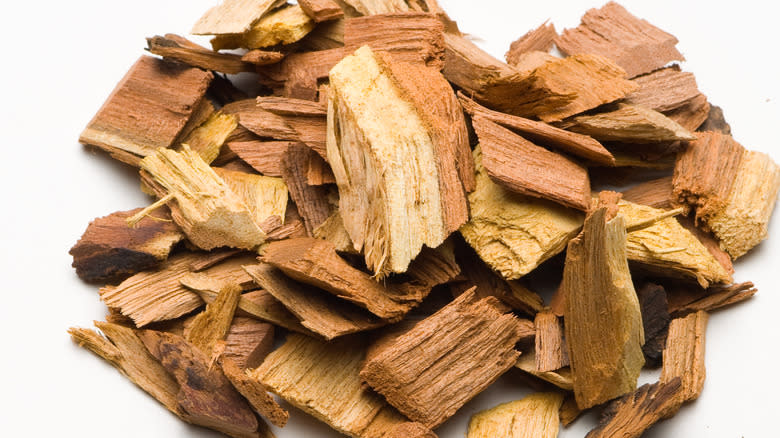
Similar to hickory but a more intense cooking wood, mesquite is often used for smoking richer cuts of beef, venison, or game since it carries a strong undercurrent that lasts throughout the cook. Sometimes overpowering more delicate foods like poultry, the sharpness of mesquite marries well with heartier cuts of beef, like brisket or ribs.
"Mesquite is one of, if not the, strongest smoking wood available. Found mostly in southern regions of the U.S., mesquite is a popular choice in the western U.S., like in Texas, as well as northern Mexico and South America," Will Hair told Tasting Table. "Mesquite burns hot and fast, and produces a lot of smoke with a strong earthy flavor."
Since the mesquite burns really hot, it's also a good way to achieve a hot bed of coals quickly. But just like hickory wood, mesquite can impart a bitter flavor if overdone. It's best to add mesquite flavor to dark meats, and then you can pair it with nut or fruit woods — such as pecan, apple, pear, peach, and cherry — to create various culinary combinations. The sweetness of the fruit wood balances the strength of the mesquite to help you avoid a bitter ending.
Alder
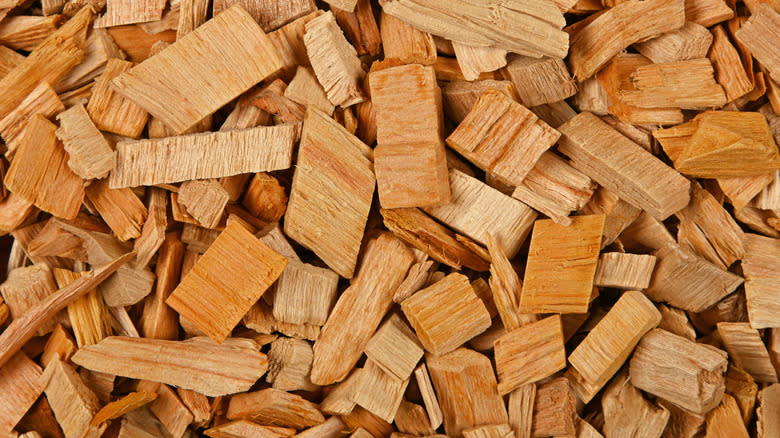
Alder wood, in the same family as birch, may not be one of the first cooking woods you think of for smoking and grilling — but unlike most cooking woods used to smoke meat or other foods, alder is commonly chosen for more delicate foods like fish and poultry.
"Alder wood is the only choice I go to for salmon or trout, as I'm more interested in the flavors of the fish standing out, rather than a strong wood smoke flavor," Will Hair shared with us.
Alder is much milder than woods such as mesquite or hickory, which are considered heavier smoking woods. Producing a lighter hint of smoke, alder wood stays more in the background rather than presenting itself upfront. It enhances your food rather than dominating the dish.
Alder planks are also a popular for grilling flavorful seafood because fish is such a quick-cooking meat. Using a plank enables you to enjoy the taste of smoked fish without going through the lengthy process of smoking it for hours.
Cherry
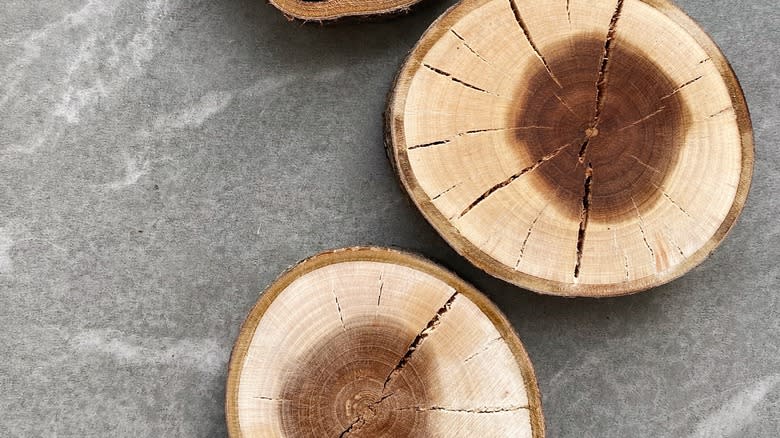
Cherry wood features a mild, fruity, and sweet profile that goes well with just about any meats. "Its sweetness lends itself well to mix with other woods," Will Hair told us. "It also works well for poultry, pork, cured meats such as hams or sausages, and even wild game — duck or goose, specifically." And since it features a less intense smokiness than other woods, cherry can be used to smoke fish as well without overpowering the delicate nature of seafood. And should you venture into the world of wood-smoking your cocktails, consider using cherry wood to sweetly boost your liquid spirits, or to create smoked drink ingredients like vanilla beans or citrus peels.
A bonus with cherry wood is that it gives your food a red hue, enhancing the aesthetics of your smoking creation. However, Hair warned us that a long cherry smoke may give your food an almost black appearance, which could be a turnoff since we initially feast upon food with our eyes. Because of this, Hair adds cherry near the end of the cooking time in order to achieve both great flavor and pleasing color with smoked meats.
Pecan
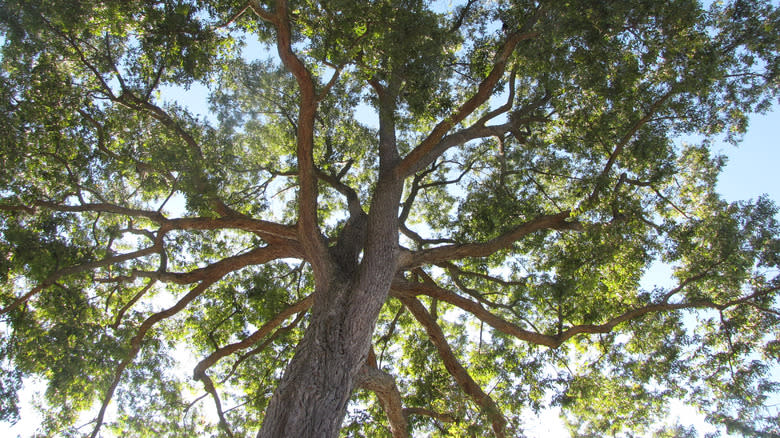
A popular type of wood for smoking and grilling meat — especially in the South, where pecan trees grow in abundance — pecan wood gives off a nutty smoke that enriches many different foods. Frequently combined with fruit woods, such as apple and cherry, pecan wood is a go-to for helping add a rich balance without completely taking over the flavor profile.
Tasting Table asked Will Hair what foods can be smoked with nut woods. "The better question would be, what can't you smoke with them," Hair responded. "Large meats absolutely benefit from the strong flavors, such as pork shoulders, butts, briskets and definitely whole hog." He further detailed that while pretty much most food benefits from pecan wood smoke, a little goes a long way for "a delicate protein" like poultry and fish.
If you're looking to explore beyond the arena of smoking meats, pecan is also one of the best types of wood to use for smoked mac and cheese. Yum.
Peach
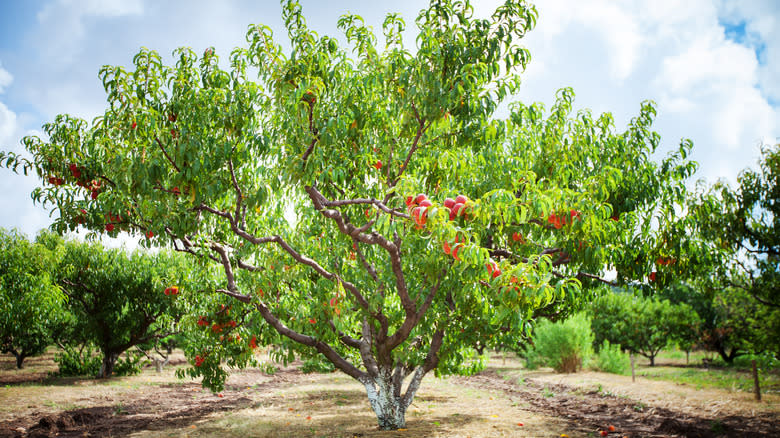
Peach is another fruit wood that's great for adding subtle, sweet notes of smoke. Commonly used to smoke poultry and pork with its mild, fruity undertones, peach wood is sometimes combined with other woods such as pecan and oak to create layers of flavor and depth of smokiness to your barbecued food.
Peach wood is used in conjunction with stronger hardwoods like hickory to balance out the intensity, so that foods don't turn bitter from lengthy cook times. Will Hair uses peach wood as part of a mix for smoking brisket, along with oak and hickory.
Hair added that a preference for using peach can largely depend on if the wood can be easily sourced locally. "If you find yourself in southern Georgia, pecan and peach wood may be available in every back yard or roadside orchard in the area." So if you're located in the southern U.S., consider picking up some peach wood for your next barbecue session.
Cedar
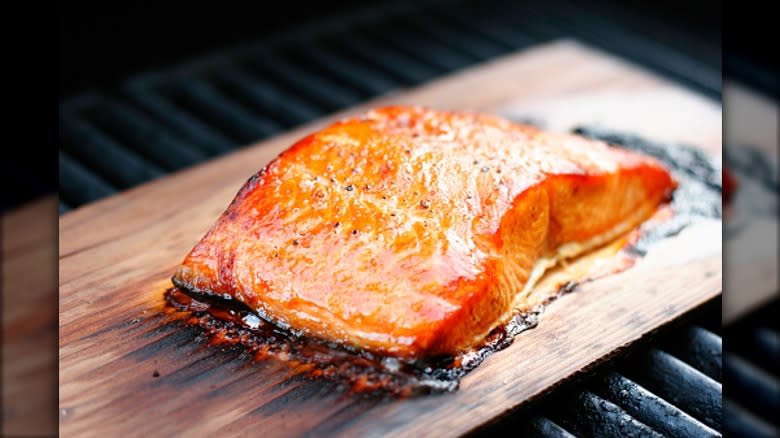
Cedar wood is better suited for short periods of grilling instead of using it as a wood that's burned slowly for smoking. Cedar is classified as a softwood, which is generally regarded as one of the types of wood to never use for smoking and grilling in the form of chunks, chips, pellets, or logs. Cedar creates thick smoke that coats food with soot, which can be a health hazard. However, using cedar in the form of planks as cooking surfaces can be a great choice for grilling foods that require short cook times, such as fish.
Planks are flat, slender pieces of wood that are placed on top of your grill grates for cooking your food, as opposed to using chips or pellets that are burned in the flames. Cedar planks are used like a pan for your fish to cook on, contributing seasoning but also aiding in holding fragile seafood together so it doesn't fall through your grill grates as it cooks. We're big fans of cedar plank salmon, and we suggest you give it a try if you haven't already.
Almond
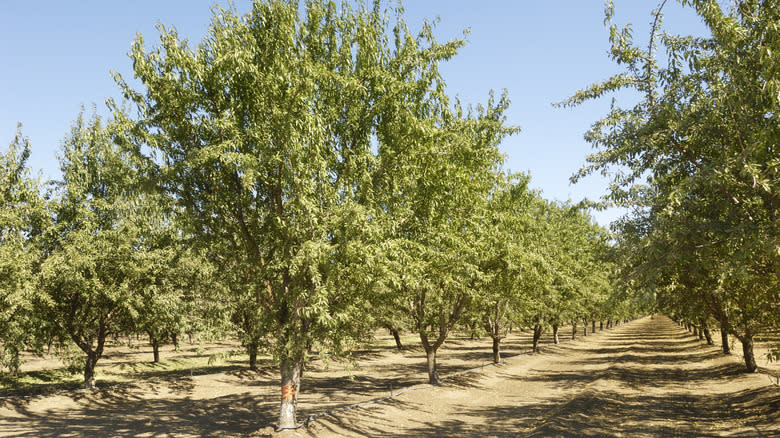
Almond wood is not as easily accessible as more common types of cooking wood, but it's comparable to pecan and some fruit woods — a little nutty, sweet, and subtle in flavor. Milder than oak, apple, or cherry woods, almond wood contributes a light touch of sweet smokiness that harmonizes with almost any type of meat. But since it's such a mild wood with a lengthy burn time, it's best used for extended cooking or as an accent wood to enhance other woods and the taste of your barbecue foods.
If you're looking for a hint of sweet smoke added to your meat, almond wood may be a good type to try. Will Hair told Tasting Table that he was excited to try almond wood, but was left rather disappointed with the final result. While almond wood doesn't rank too high on our list of woods to use for smoking and grilling, it's still worth experimenting with.
Citrus
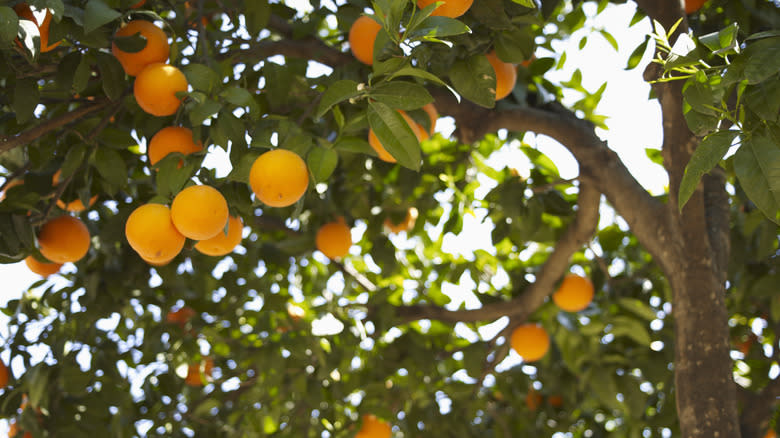
Citrus wood isn't typically lumped in with the rest of the fruit woods used for grilling and smoking, so it may get overlooked, but given the popularity of pairing citrus with meat, veggies, and fish in cuisines around the world, it's a natural connection to make. Bringing a mild, somewhat tangy, and sweet note to the foods you smoke it with, citrus wood lends a fresh, tart smokiness to fish, poultry, and pork.
Will Hair shared with Tasting Table that he's never tried smoking with citrus wood, but he infers that it provides a "light fruity flavor, but the smoke is extremely mild, so it takes a very long slow smoke to really impart any of that flavor and be able to tell that it is there."
So if you're setting up for a long smoke, consider using citrus wood along with a stronger hardwood such as oak or hickory.
Read the original article on Tasting Table.

